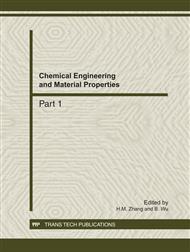p.359
p.364
p.369
p.373
p.377
p.381
p.385
p.390
p.395
Preparation of LiFePO4/C Composite Powders
Abstract:
LiFePO4/C composite powders were prepared by a simple reaction of as-synthesized FePO4•2H2O, LiOH•H2O, oxalic acid and citric acid. The influence of oxalic acid and citric acid in different ratios was investigated on morphology and electrochemical performance of LiFePO4/C composite powders. The characterization of the composites included X-ray diffraction (XRD) and scanning electron microscopy (SEM). The XRD analysis indicates that the material is well crystallized without impurities. The obtained LiFePO4/C composite powders with well dispersion at CA/OA ratio of 1:1.50 and the initial charge capacity reached 159.3 mAhg-1 at 0.1C rate, meanwhile, the particles prepared at 1:0.75 were close to spherical in shape and the specific capacity value was 149.8 mAhg-1 at 0.1C rate, with a slight decrease on greater C-rates reaching 141.3 mAhg-1 at 1C.
Info:
Periodical:
Pages:
377-380
Citation:
Online since:
December 2011
Authors:
Keywords:
Price:
Сopyright:
© 2012 Trans Tech Publications Ltd. All Rights Reserved
Share:
Citation:


